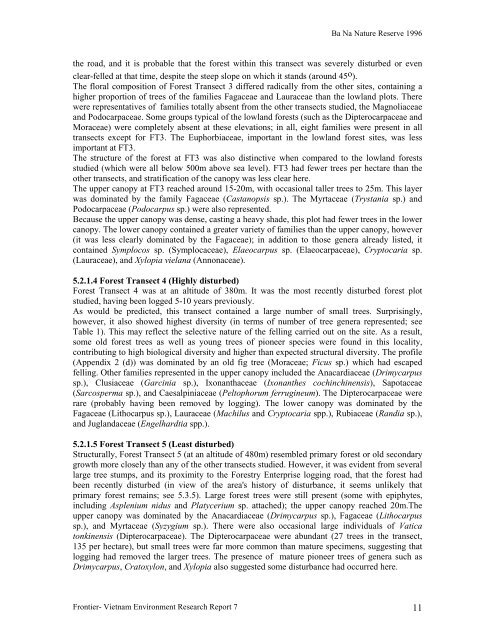Frontier Tanzania Environmental Research - Frontier-publications ...
Frontier Tanzania Environmental Research - Frontier-publications ...
Frontier Tanzania Environmental Research - Frontier-publications ...
Create successful ePaper yourself
Turn your PDF publications into a flip-book with our unique Google optimized e-Paper software.
Ba Na Nature Reserve 1996<br />
the road, and it is probable that the forest within this transect was severely disturbed or even<br />
clear-felled at that time, despite the steep slope on which it stands (around 45 o ).<br />
The floral composition of Forest Transect 3 differed radically from the other sites, containing a<br />
higher proportion of trees of the families Fagaceae and Lauraceae than the lowland plots. There<br />
were representatives of families totally absent from the other transects studied, the Magnoliaceae<br />
and Podocarpaceae. Some groups typical of the lowland forests (such as the Dipterocarpaceae and<br />
Moraceae) were completely absent at these elevations; in all, eight families were present in all<br />
transects except for FT3. The Euphorbiaceae, important in the lowland forest sites, was less<br />
important at FT3.<br />
The structure of the forest at FT3 was also distinctive when compared to the lowland forests<br />
studied (which were all below 500m above sea level). FT3 had fewer trees per hectare than the<br />
other transects, and stratification of the canopy was less clear here.<br />
The upper canopy at FT3 reached around 15-20m, with occasional taller trees to 25m. This layer<br />
was dominated by the family Fagaceae (Castanopsis sp.). The Myrtaceae (Trystania sp.) and<br />
Podocarpaceae (Podocarpus sp.) were also represented.<br />
Because the upper canopy was dense, casting a heavy shade, this plot had fewer trees in the lower<br />
canopy. The lower canopy contained a greater variety of families than the upper canopy, however<br />
(it was less clearly dominated by the Fagaceae); in addition to those genera already listed, it<br />
contained Symplocos sp. (Symplocaceae), Elaeocarpus sp. (Elaeocarpaceae), Cryptocaria sp.<br />
(Lauraceae), and Xylopia vielana (Annonaceae).<br />
5.2.1.4 Forest Transect 4 (Highly disturbed)<br />
Forest Transect 4 was at an altitude of 380m. It was the most recently disturbed forest plot<br />
studied, having been logged 5-10 years previously.<br />
As would be predicted, this transect contained a large number of small trees. Surprisingly,<br />
however, it also showed highest diversity (in terms of number of tree genera represented; see<br />
Table 1). This may reflect the selective nature of the felling carried out on the site. As a result,<br />
some old forest trees as well as young trees of pioneer species were found in this locality,<br />
contributing to high biological diversity and higher than expected structural diversity. The profile<br />
(Appendix 2 (d)) was dominated by an old fig tree (Moraceae; Ficus sp.) which had escaped<br />
felling. Other families represented in the upper canopy included the Anacardiaceae (Drimycarpus<br />
sp.), Clusiaceae (Garcinia sp.), Ixonanthaceae (Ixonanthes cochinchinensis), Sapotaceae<br />
(Sarcosperma sp.), and Caesalpiniaceae (Peltophorum ferrugineum). The Dipterocarpaceae were<br />
rare (probably having been removed by logging). The lower canopy was dominated by the<br />
Fagaceae (Lithocarpus sp.), Lauraceae (Machilus and Cryptocaria spp.), Rubiaceae (Randia sp.),<br />
and Juglandaceae (Engelhardtia spp.).<br />
5.2.1.5 Forest Transect 5 (Least disturbed)<br />
Structurally, Forest Transect 5 (at an altitude of 480m) resembled primary forest or old secondary<br />
growth more closely than any of the other transects studied. However, it was evident from several<br />
large tree stumps, and its proximity to the Forestry Enterprise logging road, that the forest had<br />
been recently disturbed (in view of the area's history of disturbance, it seems unlikely that<br />
primary forest remains; see 5.3.5). Large forest trees were still present (some with epiphytes,<br />
including Asplenium nidus and Platycerium sp. attached); the upper canopy reached 20m.The<br />
upper canopy was dominated by the Anacardiaceae (Drimycarpus sp.), Fagaceae (Lithocarpus<br />
sp.), and Myrtaceae (Syzygium sp.). There were also occasional large individuals of Vatica<br />
tonkinensis (Dipterocarpaceae). The Dipterocarpaceae were abundant (27 trees in the transect,<br />
135 per hectare), but small trees were far more common than mature specimens, suggesting that<br />
logging had removed the larger trees. The presence of mature pioneer trees of genera such as<br />
Drimycarpus, Cratoxylon, and Xylopia also suggested some disturbance had occurred here.<br />
<strong>Frontier</strong>- Vietnam Environment <strong>Research</strong> Report 7 11
















